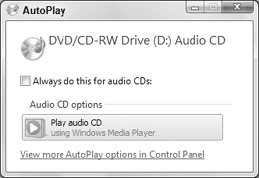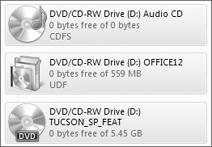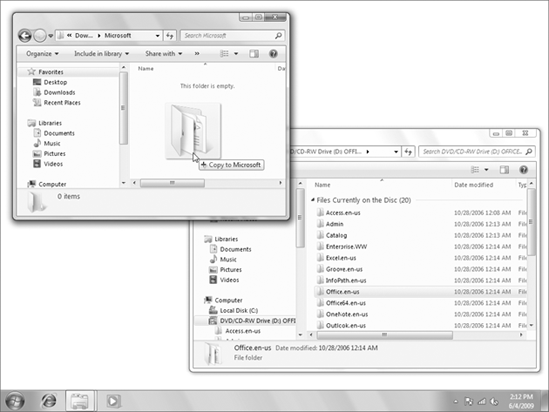Using disks that already have information
on them isn't too tough. Starting with the basics, if you have a DVD
drive, you can read (use) both CD and DVD disks. If you have a CD
drive, you can only use CD disks.
Playing the kind of CD that you buy in a music store
is usually pretty easy. You stick the CD in your CD drive and, most
likely, Windows Media Player will play it for you. To copy songs from
that kind of CD, you rip the CD in Media Player.
To watch a DVD movie, you stick the DVD in your DVD
drive and hope it plays. If you have a CD drive (not a DVD drive), it
won't play at all. To copy files from DVDs, you typically have to use
DVD ripping software.
Exactly what happens when you insert a CD or DVD
really depends on your AutoPlay options. Generally, Windows 7 does a
pretty good job of figuring out what to do. For example, you might see
an AutoPlay dialog box asking what you want to do with the CD. The
options in that dialog box depend on the contents of the disk and the
programs installed on your computer. Figure 1 shows a general example. You just click whichever option describes what you want to do.

Then again, nothing at all may happen after you
insert a CD or DVD. It all depends on the type of drive you have, the
type of disk you put in the drive, and how you've configured AutoPlay
options. But no matter what happens, you can use your Computer folder
to view the disk's contents.
1. What kind of disk is this?
Every disk drive on your system is represented by an icon in your
Computer folder. To open your Computer folder, click the Start button
and choose Computer.
|
If you want your icons to look like the ones in the examples shown here, click the Views button in the toolbar and choose Tiles.
|
|
When your CD or DVD drive contains a disk, its icon
changes to show some basic information about that disk. If the drive
can handle that type of disk, the icon shows the disk type. If there's
any empty space on the disk, you'll see just how much space there is. Figure 2
shows several examples using a single icon and how it looks with
different types of disks in it. The figure shows three examples, but
different icons are possible depending on the media type inserted in
the drive.

2. Viewing a disk's contents
To see what's already on the CD or DVD in a drive,
right-click its icon in your Computer folder and choose Open. You'll
see its contents in Explorer. As with folders on your hard disk, any
folders on the CD appear as manila file folders. Files are represented
by document icons; if the disk is empty, no icons show.
3. Copying files from a CD or DVD
To copy files or folders from a CD. But first, if you skipped straight here without reading anything else, some quick reminders on when not to use the method described here:
To copy songs from a commercial CD where songs are titled Track1, Track2, and so forth, and have .cda extensions, rip the CD using Windows Media Player.
To
copy a movie from a video DVD that has a folder named Video_TS, use DVD
ripping software to copy and convert to a more computer-compatible
format such as .avi, .mpg, or .wmv.
|
Often you can copy the .vob files to a folder on your hard disk, then change the extension to .mpg. Typically the largest .vob file is the most important one. Smaller .vob files are often just background video scenes.
|
|
|
DVD Video disks (the kind of DVD disks you rent at
video stores or create using Windows DVD Burner) store data in folders
with names like Video_TS and Audio_TS. DVD players (the kind you
connect to a TV) expect to find folders and files like that. The
Audio_TS folder may be empty because it's commonly used for DVDs that
contain music rather than video.
|
For other types of CDs that you or someone else created using a computer. For example, you can select any icons and drag them to a
folder name in the Navigation pane. Or open the destination folder in a
separate Explorer instance and drag right into the folder as shown in Figure 3.
NOTE
You must drag to a specific drive or folder name
in the Navigation pane. It won't work if you drag to empty space within
that pane.
If you specifically want to send the selected
items to your Documents folder, right-click any selected icon and
choose Send To => Documents.
|
Windows 7's AutoPlay applet makes it easy to control CD and DVD behavior.
|
|
